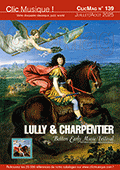 Un bon récital vaut toutes les intégrales. Certes, mais comment ne pas vouloir jouer chacune des 555 sonates de Scarlatti ? Comme d’autres, Christoph Ullrich a donc choisi de tenter l’aventure intégrale, qu’il prévoit d’achever en 2028. Sa spécificité la plus visible ? Il ne joue ni un clavecin, ni un pianoforte, ni un Bösendorfer, mais un Steinway. Et puis il y a les mots bien choisis avec lesquels il présente le compositeur : « Il n’était certainement pas d’un caractère très tranquille, ce qui s’entend dans sa musique. Entièrement tourné vers le mouvement, la danse, la joie, la lumière. Mais tout en ayant conscience du gouffre profond qui nous menace constamment. Toute légèreté est arrachée à la pesanteur, la gravité, la mélancolie. […] Sans cesse la conscience de la mortalité et de la tristesse liée à la disparition de toute chose terrestre perce à travers la gaîté apparemment désinvolte de [sa] musique. Dans les trois langues qui accompagnèrent sa vie : tristezza, saudade, tristeza. » Ce volume 11, enregistré en 2013, nous plonge immédiatement au cœur de cette passionnante odyssée. (Emmanuel Lacoue-Labarthe)  Part 1 received high praise and an excellent reception. Mirko Weber wrote the following in "Die Zeit": "Unlike Horowitz, who brought out the inner eccentricity of the pieces, or Christian Zacharias, who liberated them from the smell of mere glamour, Ullrich waits for the moment in which the music begins to float." One listener even asked the apprehensive question whether Christoph Ullrich could maintain this high level over the course of so many discs. This is a suspenseful questions! In any case, we are working diligently on the next parts, but always in manageable, varied portions. The second double-pack forms a large movement to Part 11 (out of 17) of the recently begun Scarlatti Complete Edition. With Scarlatti, it is a bit like the string quartets of Haydn: the later works might be more mature, but they are all good, right from the beginning.
|
